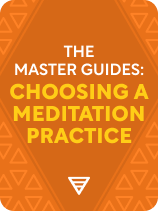

This article is an excerpt from the Shortform book guide to "The Master Guides: Choosing a Meditation Practice" by Shortform. Shortform has the world's best summaries and analyses of books you should be reading.
Like this article? Sign up for a free trial here.
What exactly is Western meditation? Is Western meditation based on religion?
Meditation in the West doesn’t come from any specific religion—instead, practitioners often believe in some form of universal consciousness. This form of meditation is often goal-oriented and can help you improve your focus.
Continue below for an in-depth look at Western meditation.
Western Meditation
While often drawing from traditional meditation philosophies and techniques, some meditation practices don’t fit neatly under any specific religion or spiritual tradition. Since these practices largely come from the United States, we’ll call this category Western meditation.
Meditation for Creating the Life You Want
Many forms of Western meditation are based on the idea that there’s a universal source of infinite power and knowledge, and you can tap into it by harnessing your thoughts and willpower. This isn’t necessarily a religious belief; some people believe that this universal source is God, but others might call it “the universe,” “Source Power,” or simply “a higher power.”
Rhonda Byrne’s book The Secret popularized this belief. In it, Byrne teaches you to take advantage of the Law of Attraction: the idea that your thoughts will “attract” whatever you think about. In other words, you can create the life you want by simply believing that it will happen.
Think of yourself as a transmission tower, like the ones used to broadcast signals to your television. Those signals become pictures on the screen. If you don’t like the show you’re watching, you change the channel to a new frequency. A new picture is broadcast. Through a similar process, your thoughts create a frequency that signals the universe, and the Law of Attraction broadcasts that signal back to you as the pictures of your life.
In You Are a Badass, Jen Sincero argues that meditation is a way to connect to the universe (what she calls Source Energy), get into top mental and spiritual shape, and create the life you want. She argues that even beyond helping you to manifest your dream life, the practice has many benefits: Meditation will bring you into the present moment, open you up to receive unlimited information and ideas, relax you, relieve stress, strengthen your intuition and focus, let you hear your inner voice more clearly, fill you with light and love, put you in a good mood, and help you love yourself.
She notes that basic meditation is quite simple:
- Sit in a comfortable cross-legged position, with your hands on your knees or in your lap.
- Sit up straight; relax your face, jawline, and forehead.
- Close your eyes (or keep them open, gazing at a spot on the ground).
- Focus on your breathing.
- Release any thoughts that come into your brain, and focus back on breathing.
- Keep your mind as clear and empty as possible; listen for flashes of intuition.
Goal-Oriented Meditation
To harness the universal source, you must have a specific goal in mind—in other words, to get what you want, you first have to know what you want. Once you know your goal, achieving it is a matter of focusing your thoughts on what you want and truly believing that it will happen.
Sincero offers the following tips for keeping your thoughts focused:
- Set a timer to avoid distracting yourself by checking a clock.
- Light a candle and focus on it. A focal point can help you get centered.
- Imagine a beam of light coming from the sky and going through you from your head through your entire body, then back up to the sky again (in other words, traveling full circle). This can help you feel more energy and light and more deeply connect you to Source Energy.
- Use a mantra. This can help you chase out unwelcome thoughts.
- Meditate first thing in the morning before starting your day. The day’s activities can distract you.
- Set an intention. Meditating is about receiving information from The Universe, as opposed to prayer, which is sending information out to The Universe. You can start with your intention and see if any answers come to you while you meditate. Or, you can meditate first, opening up the channels and clearing out the chatter; then, ask your question and see if anything comes to you.
- Consider guided meditation. Many books and videos walk you through meditation. These can be helpful when you’re just starting out and having trouble chasing out unwelcome thoughts.
- Chanting is also a way to get into a meditative state. Chanting means repeating a mantra over and over out loud, by yourself or in a group class.
- Transcendental meditation instruction may also be helpful; this involves repeating mantras and sitting twice a day for a set period of time.
Meditation for Focus
In Hyperfocus, Chris Bailey discusses how to practice meditation and mindfulness to help you “hyperfocus.” Meditation and mindfulness improve your ability to hyperfocus because they increase your working memory capacity. Your working memory capacity dictates how much information you can pay attention to—the bigger it is, the more information you can process simultaneously. Furthermore, these practices improve the quality of your attention in general.
While many people use the terms meditation and mindfulness interchangeably, Bailey does not. He explains that when you meditate, you focus on a single thing and bring your attention back to it when your mind wanders. When you practice mindfulness, you pay attention to everything you experience in a given moment. For example, if you wash dishes mindfully, you pay attention to everything that happens moment-by-moment, like how the water feels on your skin or how it sounds as it hits the sink.
To meditate, sit down and focus on nothing but your breathing for a given amount of time each day. For best results, Bailey encourages you to start small: Meditate only for an amount of time that feels easy. He also encourages trying guided meditations with apps like Headspace.
To practice mindfulness, Bailey encourages you to pick a single daily task and be mindful during it. In other words, notice everything that happens as you do that task. For best results, choose a task that occupies very little working memory, like eating a meal.

———End of Preview———
Like what you just read? Read the rest of the world's best book summary and analysis of Shortform's "The Master Guides: Choosing a Meditation Practice" at Shortform.
Here's what you'll find in our full The Master Guides: Choosing a Meditation Practice summary:
- The best, time-tested advice on meditation from meditation experts
- A look at each of the four major meditation traditions
- How to choose a meditation practice that's right for you and your lifestyle






